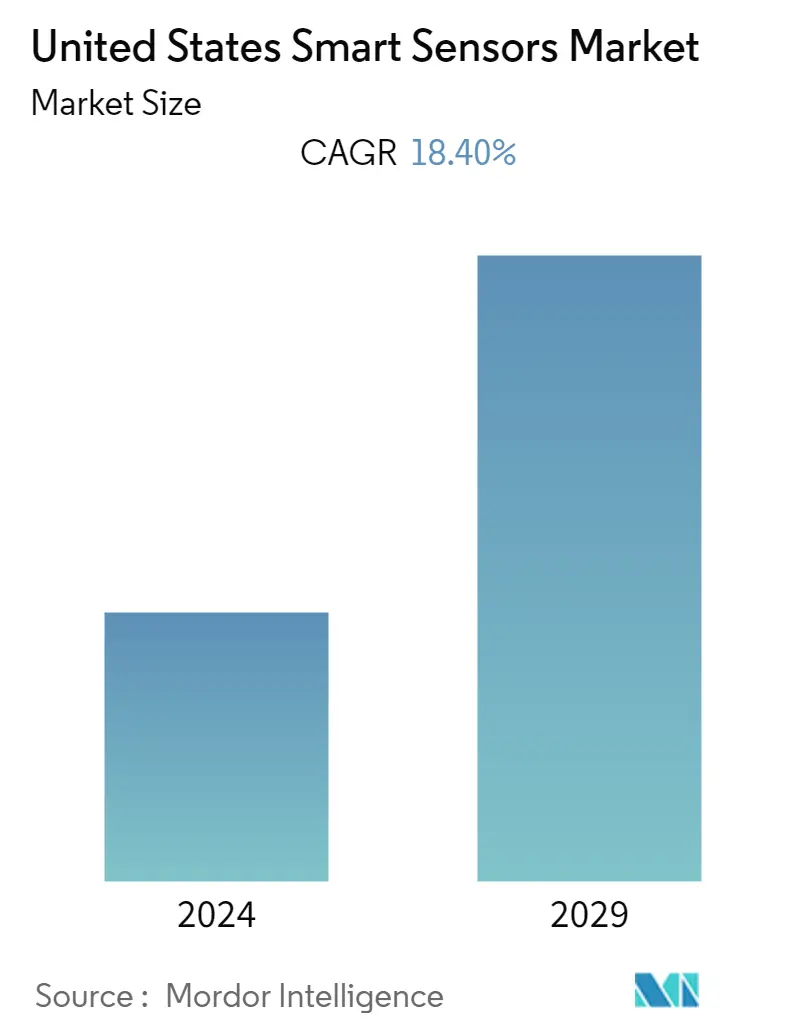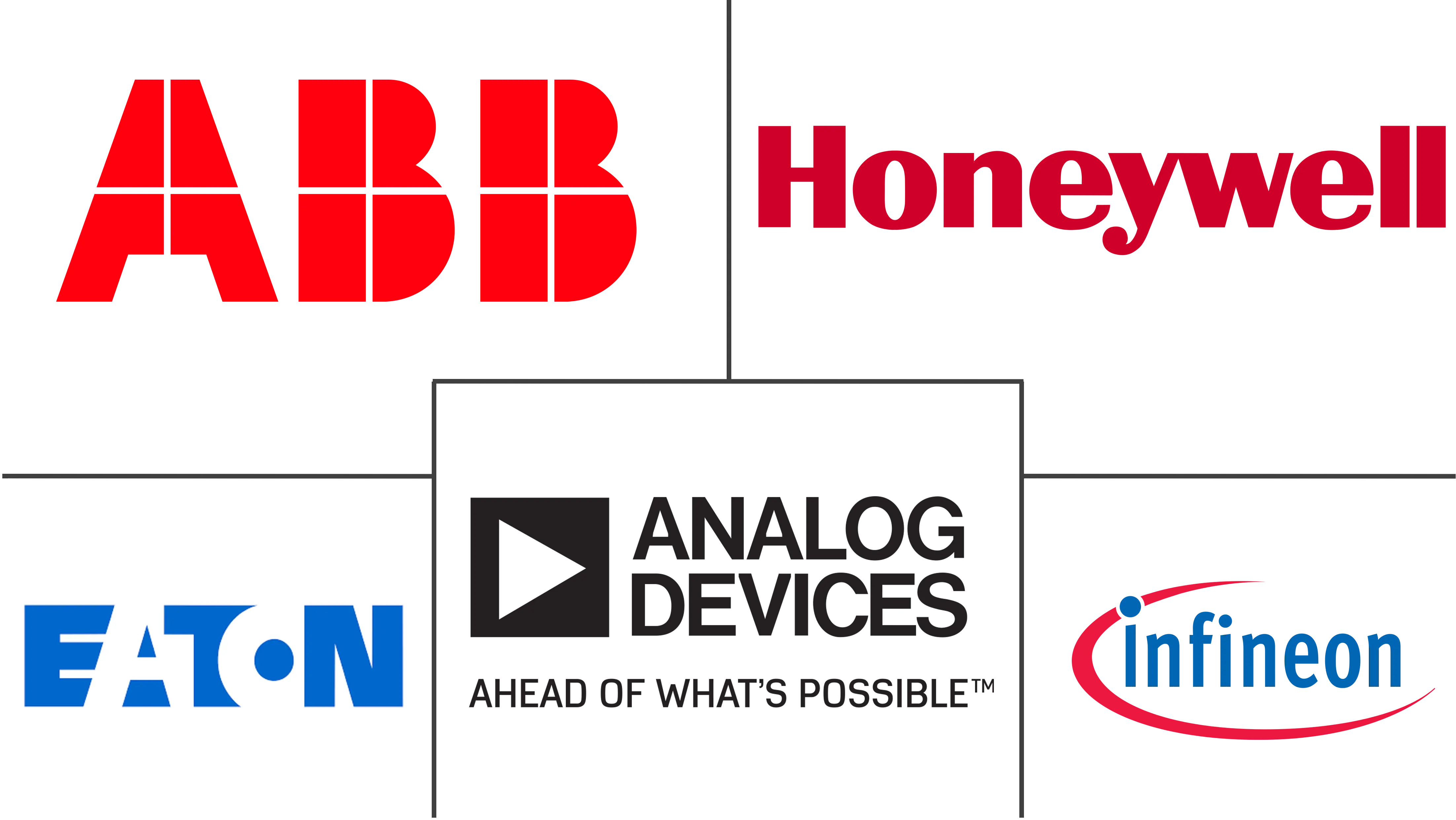Market Size of United States Smart Sensors Industry

| Study Period | 2019 - 2029 |
| Base Year For Estimation | 2023 |
| Forecast Data Period | 2024 - 2029 |
| Historical Data Period | 2019 - 2022 |
| CAGR | 18.40 % |
| Market Concentration | High |
Major Players
*Disclaimer: Major Players sorted in no particular order |
US Smart Sensors Market Analysis
The United States Smart Sensors Market is expected to grow at a CAGR of 18.4% over the forecast period. The increasing market demand for smart sensors is being driven by the growing need for energy-saving devices. The changing scenario demands energy-efficient equipment and products, considering the fact that businesses are in energy-saving mode.
- Sensors have become one of the most important and widely used components in various applications. The increasing demand for performance and efficiency has helped in the rising adoption of smart sensors over the past few years.
- These sensors represent an upgrade over conventional sensors, enabling the automated collection of environmental information with a significantly lower error rate. Smart sensors improve the following applications, Self-calibration (Adjust deviation of o/p of sensor form), Communication (Broadcast information about its own status), Cloud support (Access Big Data Analytics and machine learning (ML) algorithms), Cost-effectiveness (Less hardware and reduction of repetitive testing make smart sensors cost-effective), Multi-sensing (A single, smart sensor can measure pressure, temperature, humidity, gas flow and infrared, chemical reaction, surface, acoustic, vapor and more).
- The increasing utilization and penetration of the internet of things (IoT), coupled with increasing automation in vehicles and smart wearable systems for health monitoring, is expected to augment the growth of the smart sensors market over the forecast period. According to a study, nearly 1.3 million people die in road crashes each year, on average, 3,287 deaths per day. Hence, manufacturers are focusing on incorporating the ADAS system in passenger vehicles. Smart sensor technology is used vastly in automobiles for adaptive cruise control, park assistance, blind-spot detection, and collision avoidance.
- Companies that have integrated smart sensors in their manufacturing operations have achieved competitive advantage through improved asset management and predictive maintenance of industrial machinery. At Harley-Davidson's production facility, for example, every asset is connected, allowing management to track each step of production in real-time in a performance management system and monitor critical equipment to address potential interruptions proactively.
- Moreover, industry 4.0 influenced OEMs to adopt IoT across their operations. Maryville University estimated that by 2025 over 180 trillion gigabytes of data would be created globally every year. Industrial IoT (IIoT)IIoT-enabled industries are expected to generate a large portion of the data. A survey by industrial IoT (IIoT) giant Microsoft found that 85% of companies have at least one IIoT use case project. This number is expected to rise, as 94% of respondents said they would implement IIoT strategies by 2021.
- Additionally, the COVID-19 outbreak forced companies globally to adjust their strategies to survive in the "new normal." The outbreak affected the various manufacturing industries, resulting in a temporary shutdown of industrial operations. The supply chain's disruption affected the production of consumer electronics, automotive, healthcare devices, and other sectors, which are prominent adopters of smart sensors.
US Smart Sensors Industry Segmentation
Sensor with Integrated Circuits forms smart sensors that gather analyses and give instructions as per the built-in logic. Some of the benefits associated with these sensors are scalability, reliability, and cost-effectiveness. These are widely used in industries like aerospace & defense, automotive, consumer electronics, and others.
The United States Smart Sensors Market is segmented by Type (Flow Sensors, Image Sensors, Position Sensors, Pressure Sensors, Temperature Sensors), Technology (MEMS, CMOS, Optical spectroscopy), Component (Analog-to-Digital Converters, Digital-to-Analog Converters, Amplifiers), and by Application (Aerospace and Defense, Automotive and Transportation, Healthcare, Industrial Automation, Building Automation, Consumer Electronics).
| By Type | |
| Flow Sensors | |
| Image Sensors | |
| Position Sensors | |
| Pressure Sensors | |
| Temperature Sensors | |
| Other Types |
| By Technology | |
| MEMS | |
| CMOS | |
| Optical Spectroscopy | |
| Other Technologies |
| By Component | |
| Analog-to-Digital Converters | |
| Digital-to-Analog Converters | |
| Amplifiers | |
| Other Components |
| By Application | |
| Aerospace and Defense | |
| Automotive and Transportation | |
| Healthcare | |
| Industrial Automation | |
| Building Automation | |
| Consumer Electronics | |
| Other Applications |
United States Smart Sensors Market Size Summary
The United States smart sensors market is poised for significant growth, driven by the increasing demand for energy-efficient devices and the integration of advanced technologies like the Internet of Things (IoT) and Industry 4.0. Smart sensors, which offer enhanced performance and efficiency over traditional sensors, are becoming integral in various applications, including automotive, healthcare, and smart home systems. These sensors facilitate automated data collection with reduced error rates and support features such as self-calibration, communication, and cloud integration. The automotive sector, in particular, is witnessing a surge in the adoption of smart sensors for advanced driver-assistance systems (ADAS), enhancing vehicle safety and automation. Additionally, the COVID-19 pandemic has accelerated the adoption of smart sensors in industries by necessitating contactless solutions and optimizing manufacturing processes.
The market is characterized by the presence of major players like Infineon Technologies, Microchip Technology, and Honeywell, among others, who are continuously innovating to meet the growing demand. The development of new technologies, such as micro and nanotechnology, is further propelling the market, offering reliable and cost-effective sensor solutions. Smart sensors are increasingly being used in smart factories to improve asset management, predictive maintenance, and production efficiency. The integration of artificial intelligence and machine learning with smart sensors is expected to enhance data analysis and decision-making processes, driving further market expansion. As industries continue to embrace automation and IoT, the smart sensors market in the United States is set to experience robust growth, offering substantial opportunities for innovation and investment.
United States Smart Sensors Market Size - Table of Contents
-
1. MARKET INSIGHTS
-
1.1 Market Overview
-
1.2 Industry Attractiveness - Porter's Five Forces Analysis
-
1.2.1 Bargaining Power Of Suppliers
-
1.2.2 Bargaining Power Of Buyers
-
1.2.3 Threat Of New Entrants
-
1.2.4 Threat Of Substitutes
-
1.2.5 Intensity Of Competitive Rivalry
-
-
1.3 Industry Value Chain Analysis
-
1.4 Technology Snapshot
-
1.5 Assessment of the Impact of Covid-19 on the Market
-
-
2. MARKET SEGMENTATION
-
2.1 By Type
-
2.1.1 Flow Sensors
-
2.1.2 Image Sensors
-
2.1.3 Position Sensors
-
2.1.4 Pressure Sensors
-
2.1.5 Temperature Sensors
-
2.1.6 Other Types
-
-
2.2 By Technology
-
2.2.1 MEMS
-
2.2.2 CMOS
-
2.2.3 Optical Spectroscopy
-
2.2.4 Other Technologies
-
-
2.3 By Component
-
2.3.1 Analog-to-Digital Converters
-
2.3.2 Digital-to-Analog Converters
-
2.3.3 Amplifiers
-
2.3.4 Other Components
-
-
2.4 By Application
-
2.4.1 Aerospace and Defense
-
2.4.2 Automotive and Transportation
-
2.4.3 Healthcare
-
2.4.4 Industrial Automation
-
2.4.5 Building Automation
-
2.4.6 Consumer Electronics
-
2.4.7 Other Applications
-
-
United States Smart Sensors Market Size FAQs
What is the current United States Smart Sensors Market size?
The United States Smart Sensors Market is projected to register a CAGR of 18.40% during the forecast period (2024-2029)
Who are the key players in United States Smart Sensors Market?
ABB Ltd., Honeywell International Inc., Eaton Corporation Plc., Analog Devices, Inc. and Infineon Technologies are the major companies operating in the United States Smart Sensors Market.

